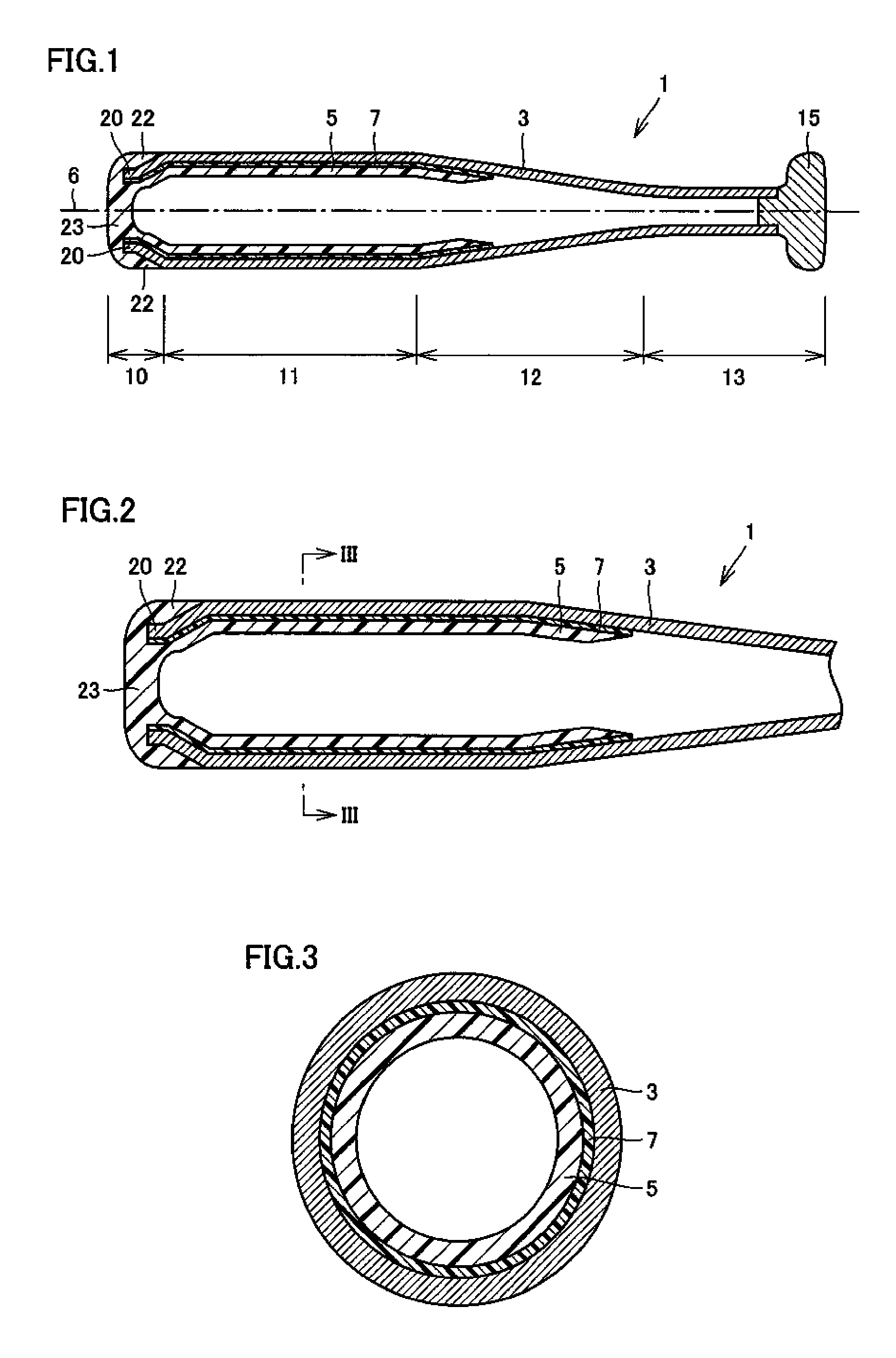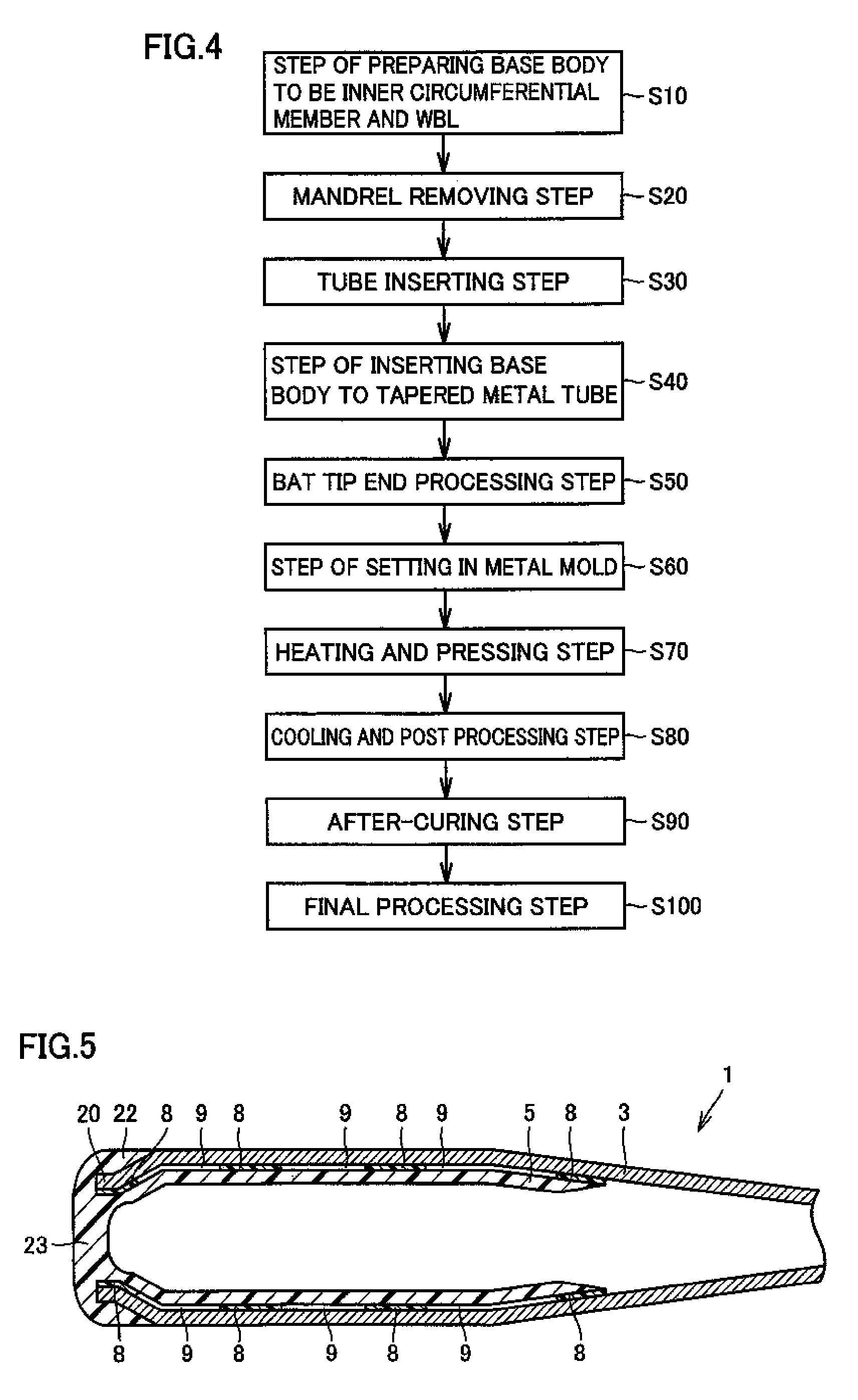Baseball or softball bat
a softball bat and base ball technology, applied in the field of softball bats, can solve the problems of unsatisfactory hitting feeling and not much improved restitution characteristic at the hitting portion of the bat, and achieve the effect of preventing degraded hitting feeling and improving restitution characteristi
- Summary
- Abstract
- Description
- Claims
- Application Information
AI Technical Summary
Benefits of technology
Problems solved by technology
Method used
Image
Examples
embodiment 1
[0047]Referring to FIGS. 1 to 3, Embodiment 1 of the bat in accordance with the present invention will be described.
[0048]Referring to FIGS. 1 to 3, a bat 1 in accordance with the present invention includes, from the tip end side, a tip end 10, a hitting portion 11, a tapered portion 12 and a grip portion 13. Bat 1 includes an outer circumferential member 3 extending from tip end 10 to grip portion 13 and defining the shape of the bat as a whole; an inner circumferential member 5 adhered to outer circumferential member 3 on the side of tip end 10 of outer circumferential member 3; a grip end 15 connected and fixed to outer circumferential member 3 at the end of grip portion 13 (rear end of bat 1); and a non-adhesive portion 7 as a weak boundary layer (WBL) arranged between outer circumferential member 3 and inner circumferential member 5 positioned on the side of inner circumferential surface at hitting portion 1 of outer circumferential member 3. At hitting portion 11, as shown in ...
embodiment 2
[0073]Referring to FIGS. 6 and 7, Embodiment 2 of the bat in accordance with the present invention will be described. FIGS. 6 and 7 correspond to FIGS. 2 and 3, respectively.
[0074]Bat 1 shown in FIGS. 6 and 7 basically has the same structure as the bat shown in FIGS. 1 to 3, with the structure of inner circumferential member 5 made different. Specifically, in bat 1 shown in FIGS. 6 and 7, inner circumferential member 5 consists of concentric inner circumferential member parts 5a, 5b and a non-adhesive portion 7b. Non-adhesive member 7b is positioned between inner circumferential member parts 5a and 5b. Non-adhesive portion 7b is arranged to extend from the taper side end portion 5 of inner circumferential member part 5b to the tip end 23 of the inner circumferential member. As a result, inner circumferential member parts 5a and 5b are movable independent from each other at the side of tapered portion 12, while they are connected on the side of tip end 23 of the inner circumferential...
embodiment 3
[0082]Embodiment 3 of the bat in accordance with the present invention will be described with reference to FIG. 9. FIG. 9 corresponds to FIG. 2.
[0083]Referring to FIG. 9, bat 1 of the present invention basically has the same structure as the bat shown in FIGS. 1 to 3, with the structure of tip end portion of the bat made different. Specifically, in the bat shown in FIG. 9, as a member forming the tip end portion of bat 1, a cap member 27 is arranged to cover the end portion of outer circumferential member 3, separate from inner circumferential member 5. Cap member 27 is adhered to the outer surface of outer circumferential member 3 at tip end portion 10 (see FIG. 1) of the bat. Further, tip end 23 of inner circumferential member is arranged to fill the opening at the tip end 20 of outer circumferential member. The surface of tip end 20 of outer circumferential member as the inner circumferential surface of the opening and the outer circumferential surface of tip end 23 of inner circ...
PUM
 Login to View More
Login to View More Abstract
Description
Claims
Application Information
 Login to View More
Login to View More - R&D
- Intellectual Property
- Life Sciences
- Materials
- Tech Scout
- Unparalleled Data Quality
- Higher Quality Content
- 60% Fewer Hallucinations
Browse by: Latest US Patents, China's latest patents, Technical Efficacy Thesaurus, Application Domain, Technology Topic, Popular Technical Reports.
© 2025 PatSnap. All rights reserved.Legal|Privacy policy|Modern Slavery Act Transparency Statement|Sitemap|About US| Contact US: help@patsnap.com



